While it is easy to pick up sauerkraut at the store, homemade sauerkraut is far superior with higher nutritional value and better flavour. Plus, it is versatile in that you can add other ingredients to it. This version includes carrot and caraway for a brightly coloured, flavourful kraut.

What is Sauerkraut?
Fermented vegetables and other fermented foods are gaining popularity as they are healthy foods that can offer probiotics and good bacteria to your gut and are high in several nutrients. In fact, sauerkraut has vitamin C, fiber, vitamin B6, and vitamin K. The nutritional profile of fermented cabbage is different from fresh cabbage as the fermentation process can unlock nutrients and make them bioavailable to the human body.
Researchers have found that even a small 2 tablespoon serving of sauerkraut meets the daily probiotic recommendation range (CFUs/colony forming units) compared to a probiotic supplement (reference). Sauerkraut can definitely be called a probiotic superfood!
At its most basic, sauerkraut is just thinly shredded cabbage and salt. The process of making homemade sauerkraut involves combining the cabbage and salt in a large bowl, and massaging it with your hands until enough liquid comes out of the cabbage so that the cabbage stays covered during the fermentation process. Since you want to keep the cabbage under the brine for the fermentation time, you need to weigh it down with a fermentation stone. This will keep the mixture anaerobic as oxygen exposure to the cabbage can make it go bad before it ferments.
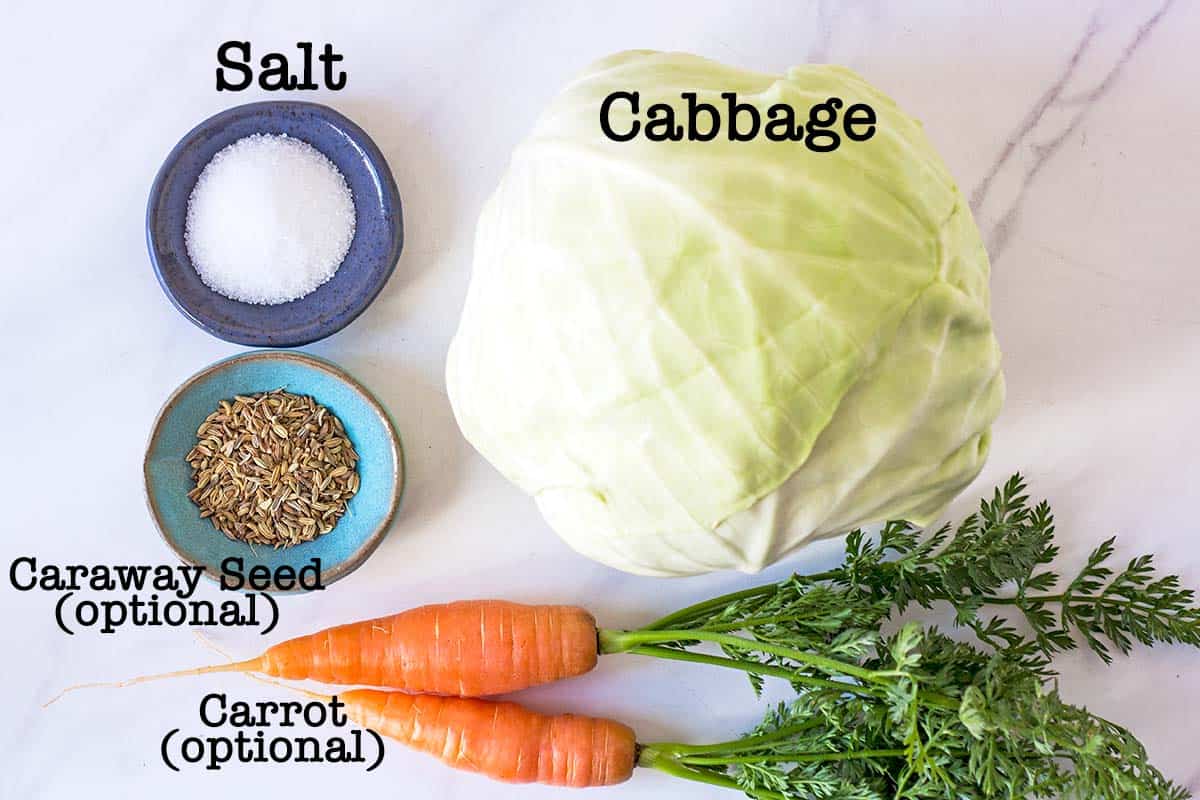
How to Make Homemade Sauerkraut
This homemade sauerkraut recipe includes just four ingredients: cabbage, carrots, salt, and caraway seeds. However, the carrot and caraway are optional if you would like more traditional sauerkraut.
Preparing the Vegetables
To begin making sauerkraut, you should pull a few of the exterior leaves off the cabbage, which you will be able to use to cover your sauerkraut as it is fermenting. Then, quarter and core the cabbage, and then finely shred it. To shred it, you can either use a large chef's knife or a food processor with a shredder attachment. At this point, you can grate the carrot too if you are using one.
Forming the Brine
For the next step, combine the vegetables with the salt in a large bowl. Then, let the mixture sit for 10 to 30 minutes until the cabbage and carrots start releasing liquid. After this, you can either massage the cabbage mixture with your hands so that more brine is released or use a tamper to pound the cabbage until it releases more moisture. The tamper can make the process more efficient but it can impact the texture of the cabbage and cause you to get softer sauerkraut. If you like sauerkraut with more texture, massaging the cabbage by hand is the way to go.

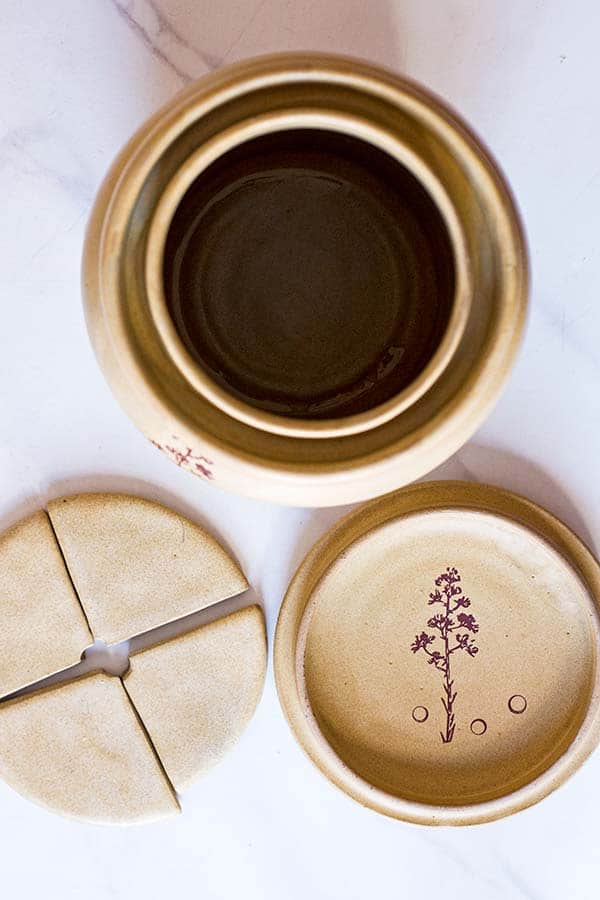
Packing the Cabbage Mixture
Once the cabbage mixture has formed enough brine, you can stir in the caraway seed if you are using it. Then, simply pack the sauerkraut mixture into jars or in a large fermentation crock, pushing the cabbage down firmly so that the cabbage's juices rise to the top. Then, you can cover the top of the cabbage with the reserved cabbage leaves followed by weights to hold the cabbage under the brine.
If you find that your cabbage didn't form enough brine, as can sometimes happen with older or drier cabbage, you can top up the jars with a 2% salt water solution. The ratio for the salt water brine should be 2 g of salt for every 100 ml of water.
From there, you can cover the jars or crock with a loose-fitting lid or towel and allow the sauerkraut to ferment for one to four weeks or until the mixture is tangy in flavour and has reached a ph of 4.6 or less. I usually go by flavor and look, but you can use pH strips to test the sauerkraut brine.
In the first week the fermentation process is quite active. The lactic acid bacteria that naturally occur on cabbage leaves thrive in their salt water brine and produce gases (mostly CO2). You will notice bubbles in your sauerkraut and maybe even some foam at the top.
It's a good idea to release some of the bubbles as too much carbon dioxide in the crock can affect the sauerkraut's flavor. Also, due to the bubbling the top of the sauerkraut may lift out of the salt water immersion. To ensure the sauerkraut stays submerged and the top doesn't get moldy, check on your fermentation once a day for the first week. Push down on your weights. This will release some of the bubbles and keep everything under the liquid.
I usually like the tanginess after 1 week of room temperature fermentation and move everything to the fridge after that. If you keep fermenting your sauerkraut for more than 1 week, you'll notice the bubbling activity slowing down and you may not have to check and push down as often or at all anymore.
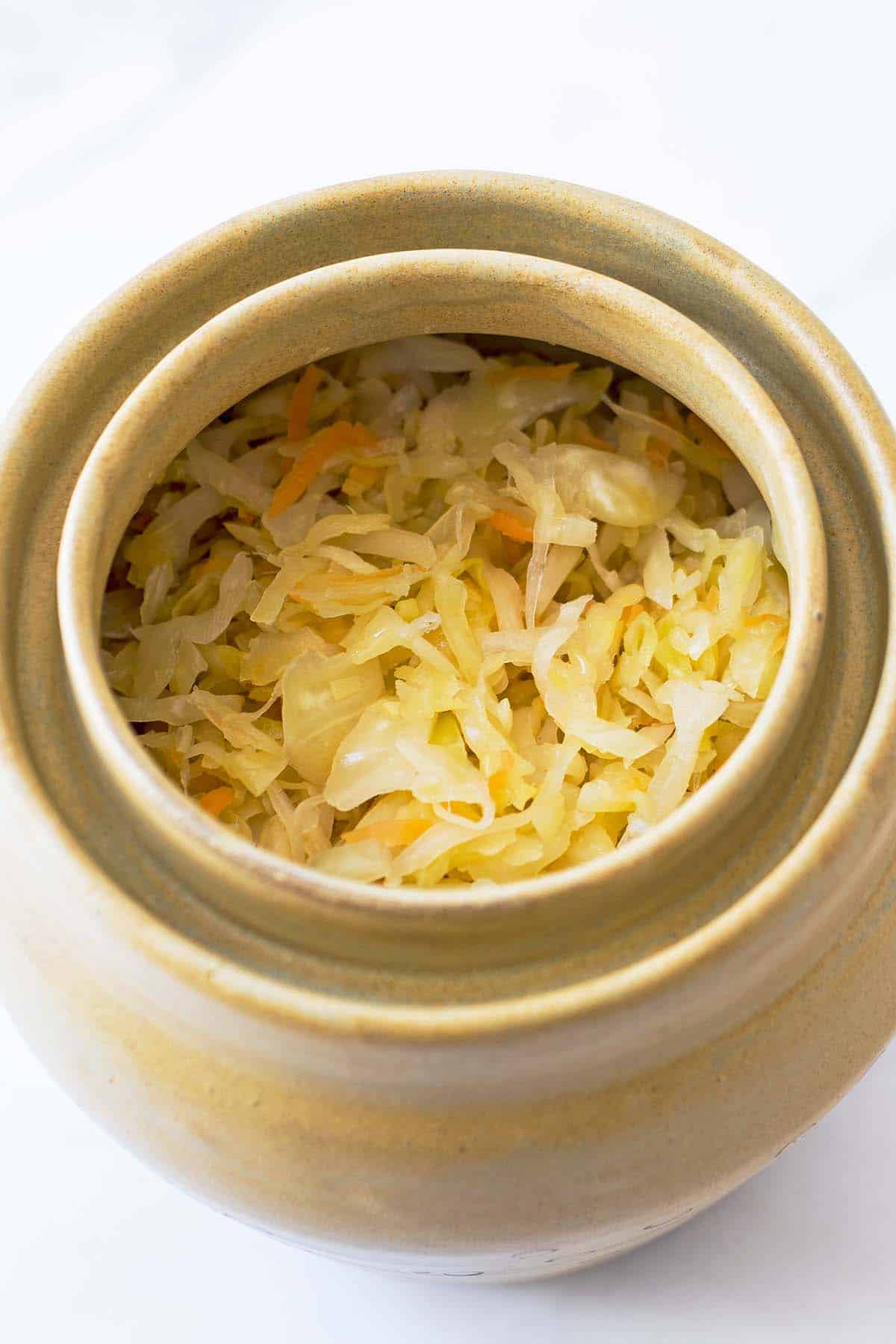
What Type of Salt Should You Use in Homemade Sauerkraut?
Many types of salt work when making homemade sauerkraut, however, you should make sure that the salt doesn't have any additives that may inhibit the fermentation process, such as iodine or anti-caking agents. For this reason, fine sea salt, kosher salt, and Himalayan pink sea salt are the best choices.
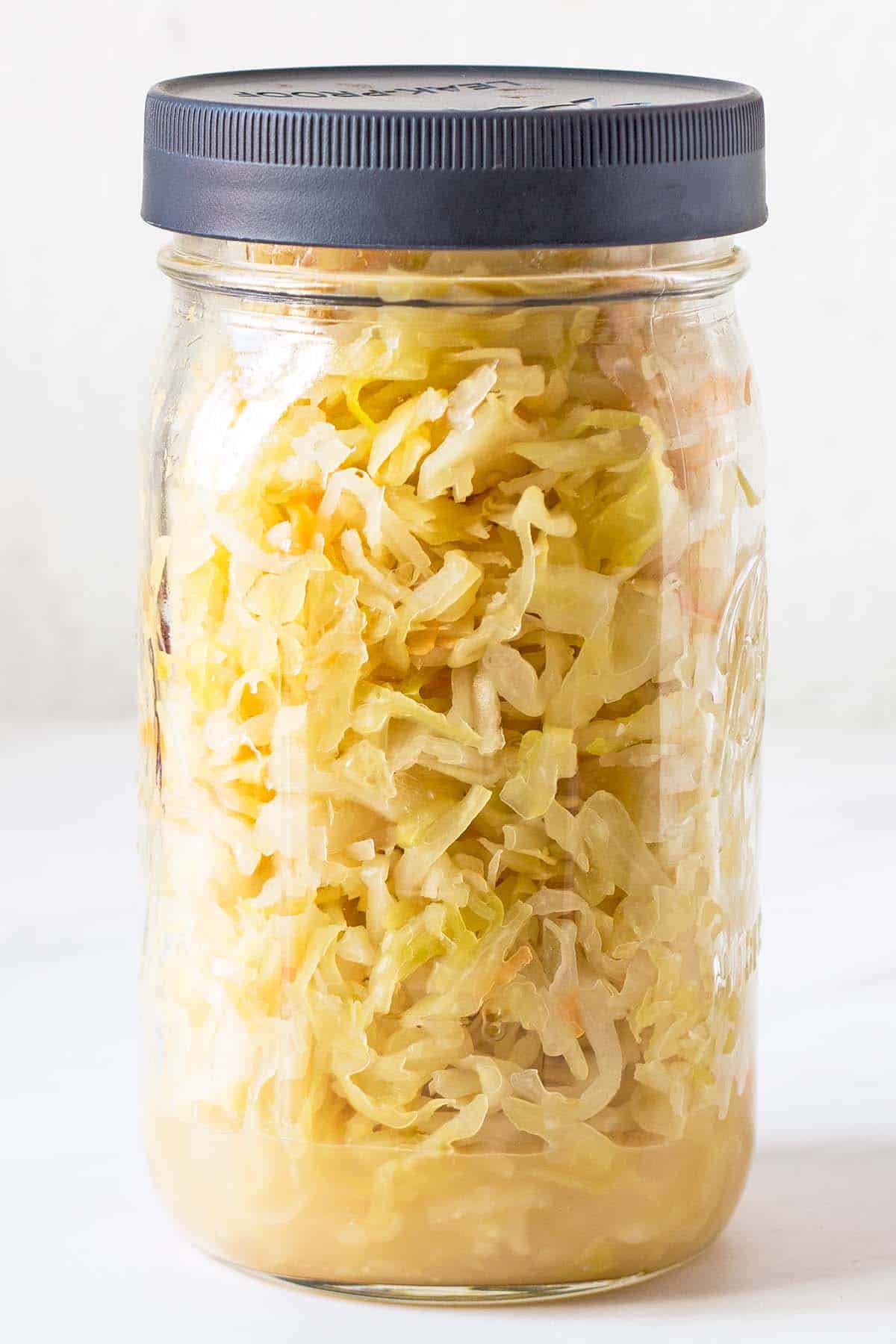
How Do I Know My Sauerkraut is Ready?
Generally, sauerkraut should only take one to four weeks to ferment, but this time can vary depending on the temperature in your home or how tangy you like your sauerkraut. Sauerkraut will ferment faster at higher temperatures than at lower temperatures. Many people prefer to ferment their sauerkraut at room temperature rather than a colder temperature as it can result in a more flavourful kraut with more texture, and a higher amount of lactobacillus bacteria.
After one week, you can taste test your sauerkraut to determine if it is tangy and if you like where the flavour is at. If you want it to be tangier, you can let it go longer. The longer the sauerkraut ferments, the better quantity of good bacteria there will be in it. Many people choose to ferment their sauerkraut for the full four weeks because of this. However, if you like a less funky flavour, you may prefer to ferment it for less time.
You can also test your sauerkraut with ph strips if you like. Properly fermented sauerkraut should be at 4.6 or lower.
There may or may not be bubbles in your sauerkraut as it is fermenting. The absence of them doesn't necessarily mean that your sauerkraut isn't doing anything, though.
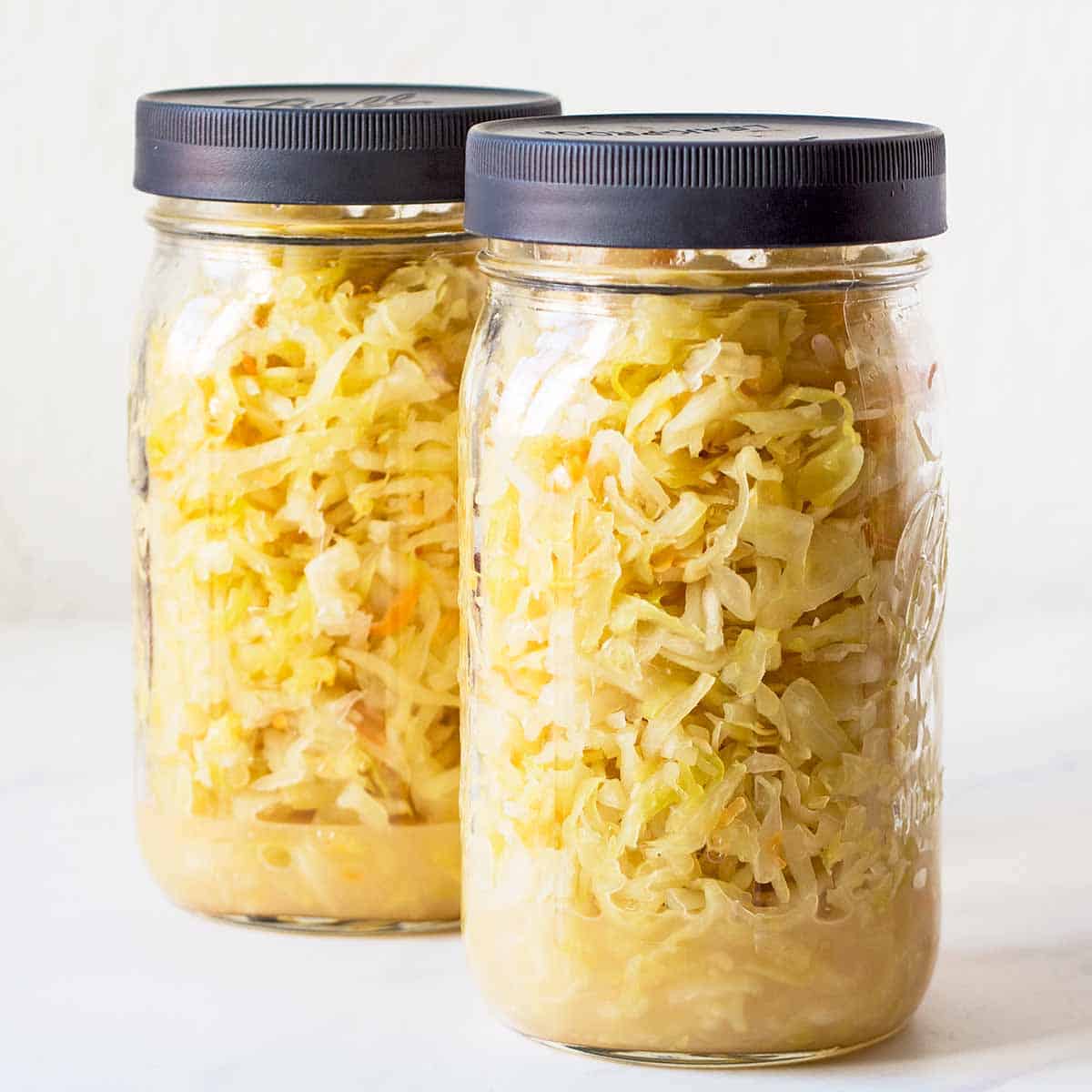
Can Homemade Sauerkraut Have Botulism?
If your sauerkraut has fermented correctly, there will be no opportunity for botulism. While it can be challenging to prevent botulism while canning foods at home, this isn't a risk with fermented foods as fermentation creates an environment that is not ideal for its production. Homemade fermented foods are produced by creating an anaerobic environment, which results in acidity not ideal for botulism. In fact, many people find that fermenting food at home is safer than canning it.
If something has gone wrong with your home ferment, you will know it, as the food will begin to rot, have a bad smell or soft texture, or grow mold on top. However, if sauerkraut does have mold on top, it doesn't necessarily mean you will have to discard the whole batch. If the rest of the kraut is ok below the brine, you can simply scoop off the mold and ensure that the sauerkraut is sufficiently pushed below the brine.
Sometimes, your batch of kraut may form a white film on top, but this may not be anything to worry about. It is called kahm yeast which sometimes occurs in ferments with either high sugar or older vegetables. It actually is quite nutritious but some people don't love the flavour that it adds. If you see this form on your ferment, you can carefully scoop it off with a slotted spoon.
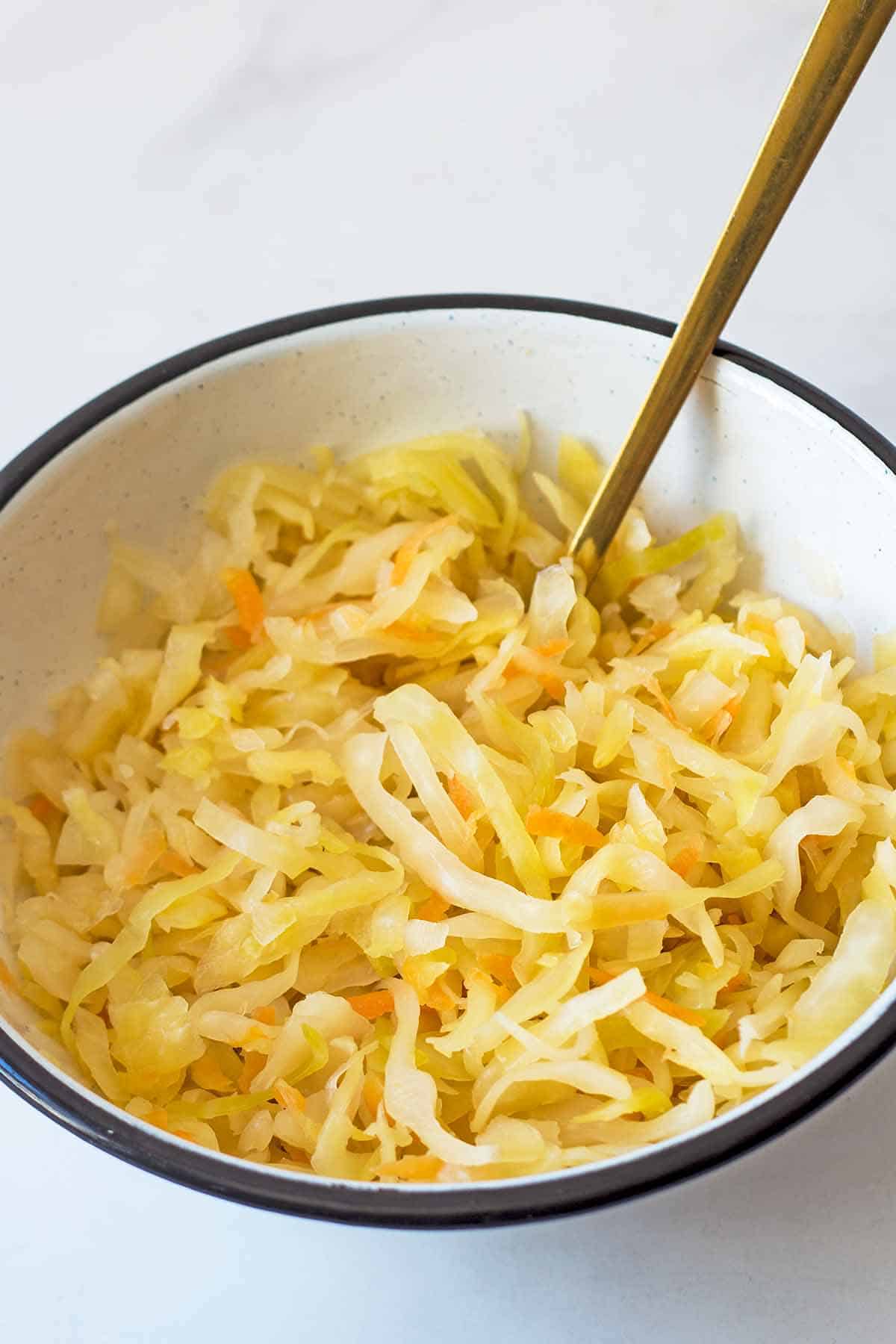
How to Store Homemade Sauerkraut
Once your sauerkraut is fermented, it just needs to go in the fridge while you enjoy it over the next four to six months. If you fermented your sauerkraut in jars already, simply remove the weights, screw on the lids, and place the sauerkraut in the fridge. You may want to open the jars once in a while to allow gasses to escape, but the activity in the sauerkraut should slow down when it is refrigerated. If you fermented your sauerkraut in a fermentation crock, you should pack it into either a large mason jar or smaller jars with lids.
Other Fermented Recipes You'll Love:
Recipe
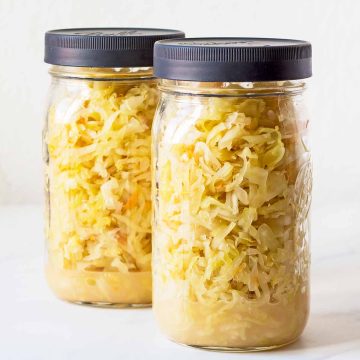
Homemade Sauerkraut Recipe
Equipment
- 1 fermentation crock or other large vessel
Ingredients
- 2.2 pounds cabbage (white or red) approximately
- 1 tablespoon (heaping) salt fine sea salt, kosher salt, or pink Himalayan salt
- 1 small carrot optional
- 2 teaspoon caraway seeds optional
Instructions
- Peel the other leaves off your head of cabbage. Save 1-2 clean leaves as covers for later.
- Cut the cabbage into quarters and remove the core. Finely shred the cabbage either with a knife or using the slicing disc on your food processor. Grate the carrot if using.
- In a large bowl toss the shredded vegetables with the salt. If you want to be very exact, use a ratio of 20g salt for 1 kg of vegetables. Let the mixture sit covered for 10-30 minutes so the salt can start drawing out the liquid from the cabbage. Together with the salt the water from the cabbage creates it own fermentation brine.
- Then start massaging/kneading the cabbage with (gloved) hands or use a tool like a tamper until a lot of liquid is released and the cabbage shreds have started to look more translucent. If using, you can now mix in the caraway seeds.
- Tightly pack the sauerkraut into jars or a fermentation crock. Keep pushing down on the vegetables so that the liquid rises to the top. Cover the surface with a whole piece of cabbage leaf cut to size. Then add weights (fermentation weights or a small jar with water) on top to keep all the vegetables submerged under the brine.
- Older/drier cabbage may not release enough liquid. In that case fill your jar up with 2% salt water brine solution (100ml water + 2 g salt) until the cabbage is covered.
- Cover with a lid or fasten a cloth towel around the jar/crock. Let the sauerkraut ferment at room temperature for 1-4 weeks until desired tanginess is reached.
- Within the first few days check on the sauerkraut 1-2 times a day. Push down on the weights as needed. The released fermentation bubbles with cause it to lift up.
- After that you can store the fermented sauerkraut in the fridge without weights, with an airtight lid for 4-6 months. Enjoy a little daily as a dinner side or mix into salads.
Nutrition
Pin for later?

Random Questions
The fermentation time for sauerkraut typically ranges from one to four weeks, depending on factors such as temperature and preferred tanginess. It's essential to taste-test the sauerkraut after a week to determine if it has reached the desired flavor.
Homemade sauerkraut can be more cost-effective than store-bought options, especially when using locally sourced vegetables. Additionally, making sauerkraut at home allows you to control the ingredients, resulting in a healthier and customized final product.
To make sauerkraut, shred cabbage and mix it with salt. Let the mixture sit to release liquid, then pack it into jars with optional ingredients like carrots and caraway seeds. Use weights to keep the cabbage submerged under brine, ferment for one to four weeks, and refrigerate.
For fermenting sauerkraut, a 2% salt water solution is recommended if the cabbage doesn't release enough brine. The ratio is 2 grams of salt for every 100 milliliters of water. It's crucial to avoid using salts with additives that might hinder the fermentation process.


Leave a Reply